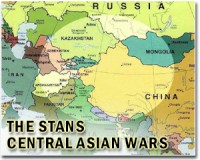| . |  |
. |
Tallinn (AFP) April 24, 2010 Nine years after US-led forces invaded Afghanistan, NATO says it now has a coherent plan to begin handing over security and governing duties to Afghan provincial authorities by November. During talks in Tallinn, Estonia, alliance foreign ministers on Friday endorsed guidelines for passing control to the Afghans as foreign forces step up efforts to drive a resurgent Taliban and Al-Qaeda from the provinces. "We agreed the approach, we will take to transition," North Atlantic Treaty Organization Secretary General Anders Fogh Rasmussen said after two days of talks in the city on the Baltic Sea. "As of today, we have a roadmap that will lead towards transition to Afghan control starting this year, at which point our publics will start to see the progress for which they have quite rightly been asking," Rasmussen said. He said he hoped that the Afghan government and the international community would endorse the plan at a conference in Kabul in mid-July, with the transfer of duties starting by November, when NATO holds its next summit in Lisbon. In the capital Kabul, the Afghans have already taken the lead in security, he said. Mark Sedwill, NATO's senior civilian representative in Afghanistan, said he expected Afghan local leaders to start assuming control in the more stable provinces stretching north and west from the Khyber Pass to Nimroz. NATO planners, he told reporters, are trying to determine the conditions where the authorities are competent enough to take the lead in security as well as provide fair and good government service and economic development. "Gradually, as the transition goes through, you would expect them to build up and us to draw down," Sidwell said. Allied troops would pull back from frontline combat and play only a supporting role in preparation for an eventual pullout, he said. The conditions, which are still being worked on, will also seek to make sure that the Afghan authorities reflect the area's right ethnic and tribal mix, Sedwill said. "If there were people excluded, even if it's quiet now, you are just storing up problems for the future," he said. The transition plan flows from the revamped strategy for Afghanistan that US President Barack Obama announced in December when he ordered the deployment of 30,000 new troops to the country. Under the plan, he set July 2011 as the date for their drawdown to begin. However, Obama has repeated that the speed of the US drawdown and departure from Afghanistan of US and allied troops would be dictated by how successful they were in stabilising the country and how quickly the Afghans can take over. The US and some 10,000 allied reinforcements are joining 90,000 troops drawn from more than 40 nations. NATO is also pressing for 450 more trainers to build up the Afghan army and police -- a key part of the plan to turn security over to the Afghans and have allied forces assume a supporting role before eventually withdrawing. Asked why it was so hard for other NATO members to come up with the numbers when Washington was deploying so many new troops, US Secretary of State Hillary Clinton told reporters she was in fact "heartened" by allies' response. "We have a relatively small gap that we're still working to fill," the chief US diplomat said. Not only did she expect the alliance to meet the numbers required but she hailed a broader spirit of cooperation. "I'm very encouraged by the close cooperation among countries and their forces, their military troops, their civilian experts, and I see everyday results of this much better coordinated approach," she added. NATO sees a troop pull-out as hinging on Afghans being able to provide their own security, promote economic development, and govern properly without tribal and ethnic rivalries sowing the seeds of renewed conflict. But, as casualties rise with the new troop surge, international forces are under growing pressure in Afghanistan and at home to leave. For this reason, Sedwill said, the foreign powers need to show people the Afghans are assuming control and the forces will eventually be able to leave. Success of the plan is "still far from certain," he acknowledged. "We will only really start to know toward the end of this year whether we are on track," Sedwill said. International troops have been in Afghanistan since late 2001, when a US-led coalition ousted its hardline Islamist Taliban regime, along with its Al-Qaeda allies who carried out the September 11 attacks in New York and Washington.
Share This Article With Planet Earth
Related Links News From Across The Stans
 China vows economic growth in restive Xinjiang
China vows economic growth in restive XinjiangBeijing (AFP) April 23, 2010 China's top leadership has decided to ramp up development in its restive Xinjiang region, state media said Friday, where ethnic Uighurs have long complained of missing out on economic growth. The decision was taken in a meeting of the ruling Communist Party's powerful nine-member inner circle presided over by President Hu Jintao, the official Xinhua news agency said. It said the move was ... read more |
|
| The content herein, unless otherwise known to be public domain, are Copyright 1995-2010 - SpaceDaily. AFP and UPI Wire Stories are copyright Agence France-Presse and United Press International. ESA Portal Reports are copyright European Space Agency. All NASA sourced material is public domain. Additional copyrights may apply in whole or part to other bona fide parties. Advertising does not imply endorsement,agreement or approval of any opinions, statements or information provided by SpaceDaily on any Web page published or hosted by SpaceDaily. Privacy Statement |